Some affine geometric aspects of operator algebras - MSP
Some affine geometric aspects of operator algebras - MSP
Some affine geometric aspects of operator algebras - MSP
You also want an ePaper? Increase the reach of your titles
YUMPU automatically turns print PDFs into web optimized ePapers that Google loves.
PACIFIC JOURNAL OF MATHEMATICS<br />
Vol. 137, No. 1, 1989<br />
SOME AFFINE GEOMETRIC ASPECTS<br />
OF OPERATOR ALGEBRAS<br />
YAAKOV FRIEDMAN AND BERNARD RUSSO<br />
Dedicated to the memory <strong>of</strong> Henry Abel Dye<br />
The predual <strong>of</strong> a von Neumann algebra is shown to be a neutral<br />
strongly facially symmetric space, thereby suggesting an <strong>affine</strong> <strong>geometric</strong><br />
approach to <strong>operator</strong> <strong>algebras</strong> and their non-associative analogues.<br />
Geometric pro<strong>of</strong>s are obtained for the polar decompositions<br />
<strong>of</strong> normal functionals in ordered and non-ordered settings.<br />
A fundamental problem in the <strong>operator</strong> algebraic approach to quantum<br />
mechanics is to determine those algebraic structures in Banach<br />
spaces which are characterized by a set <strong>of</strong> <strong>geometric</strong>al axioms defining<br />
the quantum mechanical measuring process. This problem was solved<br />
in the context <strong>of</strong> ordered Banach spaces by Alfsen, Hanche-Olsen, and<br />
Shultz ([2], [1]) and led to a characterization <strong>of</strong> the state spaces <strong>of</strong><br />
/2?*-<strong>algebras</strong> and C*-<strong>algebras</strong>. The main thrust <strong>of</strong> the present authors'<br />
recent research has been to find those algebraic structures induced on<br />
(unordered) Banach spaces in which such quantum mechanical axioms<br />
are satisfied. This project, which was initiated in [14] and [15]<br />
using the <strong>affine</strong> geometry <strong>of</strong> the dual unit ball, is used here to give a<br />
<strong>geometric</strong> pro<strong>of</strong> <strong>of</strong> the Tomita-Sakai-Effros polar decomposition <strong>of</strong> a<br />
normal functional on a von Neumann algebra.<br />
Thus, the purpose <strong>of</strong> this partially expository paper is to show the<br />
richness and power <strong>of</strong> the <strong>affine</strong> <strong>geometric</strong> structure <strong>of</strong> the dual space<br />
<strong>of</strong> an <strong>operator</strong> algebra, by working in a purely <strong>geometric</strong> model. Indeed,<br />
since this geometry can be described in terms <strong>of</strong> the underlying<br />
real structure, it can be used to obtain new results in the real structure<br />
<strong>of</strong> <strong>operator</strong> <strong>algebras</strong> and in the structure <strong>of</strong> real <strong>operator</strong> <strong>algebras</strong>.<br />
For example, by using this approach, Dang ([5]) has shown that a<br />
raz/-linear isometry <strong>of</strong> a C*-algebra is the sum <strong>of</strong> a linear and a conjugate<br />
linear isometry, and hence is multiplicative, thereby obtaining a<br />
real analogue <strong>of</strong> Kadison's non-commutative extension <strong>of</strong> the Banach-<br />
Stone Theorem.<br />
The category <strong>of</strong> strongly facially symmetric (SFS) spaces (simply<br />
called facially symmetric spaces in [14] and [15]) has been shown to<br />
123













